|
|
|
|
|
|
This review page is supported in part by the sponsors whose ad is displayed above
|
|
 |
|
Battery Power
Very few designers have successfully implemented battery power in preamps. I can think of ARS Emitter, Dodd, Edge, Silvaweld and Sutherland in this esoteric realm. Separate, massively filtered, regulated power supplies are now de rigueur in reference equipment. Therefore, one might question the need and trouble for both the designer and the end user to rely on battery power. My current VTL 7.5 and the Levinson 32 are perfect examples with power supplies as large as the amplifying section. They also weigh as much as a small power amp.
|
|
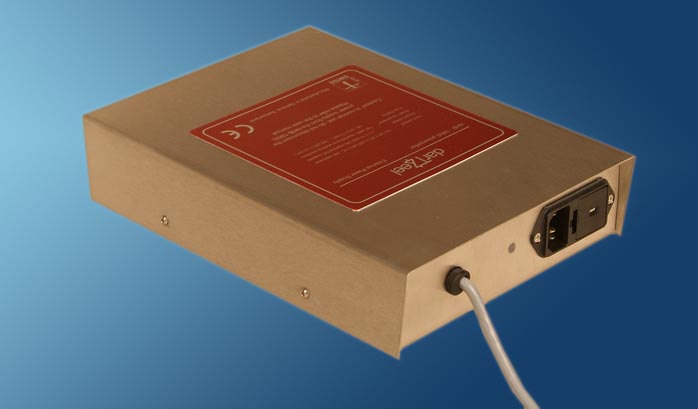 |
|
|
Many people leave their preamp on continuously to keep it in a ready-to-use state. Preamps draw relatively little power, therefore this is accepted behavior. It does not apply to the 18NS. Its battery power and automatic charging circuit preclude this. The battery system is designed to continually power the preamp as long as the batteries retain a charge. Upon discharge, the charging circuit turns on, the preamp converts to AC power and the LED on the front panel turns red to indicate charging. When the battery is charged, the indicator light returns to yellow in an automatic and continuous cycle. If you leave the preamp powered up nonstop, you'll never know the relative state of charge or discharge. You could sit down for an all-night listening session and the batteries could enter their charge cycle. Instead of listening to battery power, you're then listening to AC. It's not the end of the world. On AC the 18NS is still one of the world's best, it just loses some of the magic. There's a loss of transparency, purity and a slight increase in grain. So just turn the 18 off when you're done. Once it's broken in, it doesn't matter because it has a relatively short warm-up. After five to ten minutes in my informal tests, it's ready to go. Also, leaving the unit on causes a constant cycle of charging and discharging which will shorten battery life. The outboard supply includes the battery charging system and serves as backup power should the batteries expire. Under normal charged-battery listening, the power supply "disconnects" automatically. If you listen while the red light goes red, every minute in red mode means two minutes of battery life. If after 10 minutes of playing while charging you power the preamp off and on again, the machine will play on battery mode for 20 minutes. It means that one doesn't have to wait for a full charging cycle to enjoy battery mode. Battery mode is preferred at every power-on until battery level really needs a charge.
|
|
 |
|
|
Break-in
For me, that's a quick terminal cleaning with alcohol, an application of Walker Audio's Extreme SST contact treatment to a few connections, a push of the 'power nose' and we're ready to go. My initial unit was delivered new from the factory and I used the Stereophile break-in CD for approximately 100 hours before any serious listening. Upon initial listening, a minor glitch arose in the unit when the volume control was advanced to moderately high listening levels. After a return trip to the factory, the problem was quickly resolved. Not knowing how much playing time the unit received at the factory, I continued my break-in for three or four days while listening intermittently along the way. The sound of the unit remained consistent during this three to four day break in. The bottom line is that due to the unit's return to the factory, I cannot definitively state the required break-in time. If the 108 amp is indicative, and based upon the similarity of the circuit design, I would recommend a considerable period. There is some ongoing bickering in the audiophile community related to buying megabuck components and then being forced to spend time breaking in the product. Personally, I could not care less. For many people, the darTZeel is a lifetime purchase. Allowing a week's break-in is no big deal. Cars and other mechanical devices have break-in periods and to my ears, virtually all new electronics benefit. Get over it. Worry about important things in life.
|
|
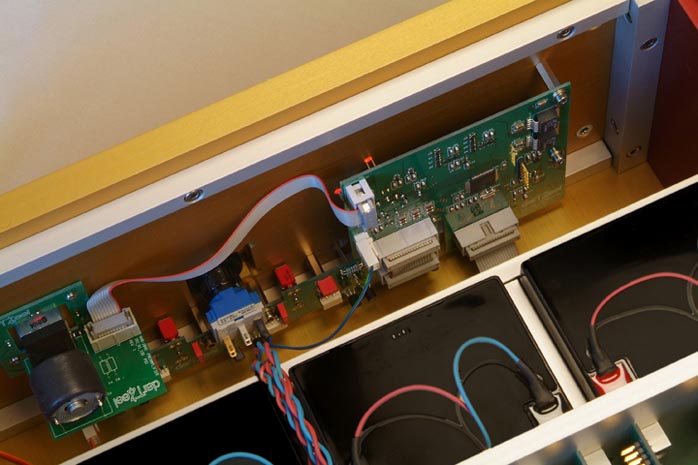 |
|
|
|
|
 |
|
The sound
Let's end the suspense - as if there was any to begin with. I was blown away by this preamp, especially its air and transparency. The sound just doesn't emanate from the speakers, it soars. On Plas Johnson's Positively [Pure Audiophile records], Johnson's tenor sax floats with wonderful precision in the room. Glenn Miller's Orchestra's direct-to-disc [The Great American Gramophone Company] is a challenging record to reproduce; the lightning fast transients, bold dynamics and intense brass of Tuxedo Junction shows off the 18's ability to nail dynamic contrasts.
|
|
| Transient response, a seamless soundstage and a top-to-bottom coherence place the 18NS at the top of the charts. Think electrostatic and Kharma speakers. When set up properly, both produce a most wonderfully coherent and seamless presentation. The 18NS is the electronic component version thereof. The comparison of course is conceptual. I'm not saying that the darTZeel will make your system sound like a Sound Lab or Karma Exquisite. What I am saying is that these components bring a seamless focus to the table. The ability to hear and resolve various instruments in real space without any artificial etch puts the 18NS in rarefied strata. |
|
|
Every amp or preamp in my experience exhibits some degree of smearing, often as the music increases in complexity yet the 18 preserves clarity regardless of the musical complexity. Almost any system can reproduce the first half of Ravel's Bolero [Stanislaw Skrowaczewski, Minnesota Orchestra, Reference Recordings] in its utter simplicity. About halfway through when the strings make their entrance, the wonderful initial eloquence at times can bog down as the ever increasing complexity congests low-level detail. When the horns enter, the chaotic crescendo can leave many components in the dust but the 18NS keeps consistent focus and resolution with zero stridency.
|
|
|
|
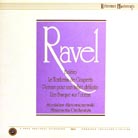 |
|
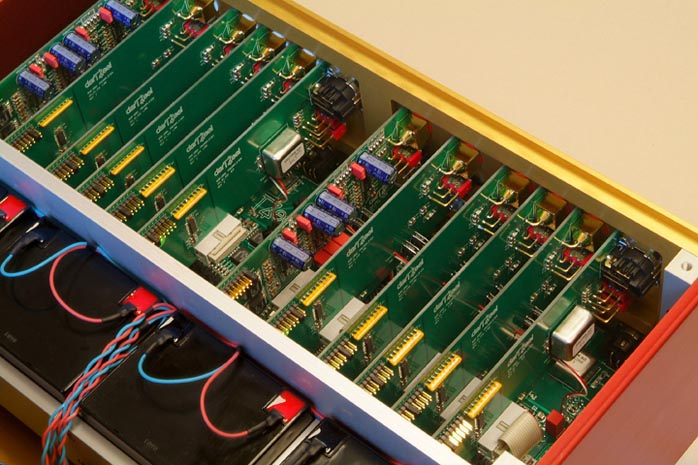 |
|
Transparency, Clarity and Resolution
By no small margin, the 18NS is my personal champion in the resolution arena. It offers remarkable transparency. When it comes to coherence, detail and resolution existing within an extraordinary musical framework, the d'art is in a class by itself, revealing the source with no definable euphonic coloration. It's one thing to extract detail from a small jazz ensemble; quite another for a full orchestra. Playing with the delicacy that is the "Meditation" by Jules Massenet from Clair de Lune [Raymond Agoult, London Symphony Orchestra, Classic Records], all sensuous and soothing, the 18NS provides a wonderful balance between micro-dynamic clarity and liquidity.
The Brazilian sleigh bells in Hi-fi A La Española [Fennell, Eastman-Rochester Pops, Mercury] are light and airy, displayed with precision and perfect musical balance. I've heard them too soft and round and at other times harsh, grating and sterile. The 18 gets it just right.
Don't confuse the fundamental difference between clarity and apparent clarity. To use a video comparison, turning up the video sharpness control might have the appearance of more detail but in reality it obscures the smallest details. This is provable by test patterns and by people far more knowledgeable than me. In the audio analogy, the 18NS defines the difference between clarity and apparent clarity.
|
|
|
|
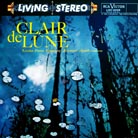 |
|
 |
|
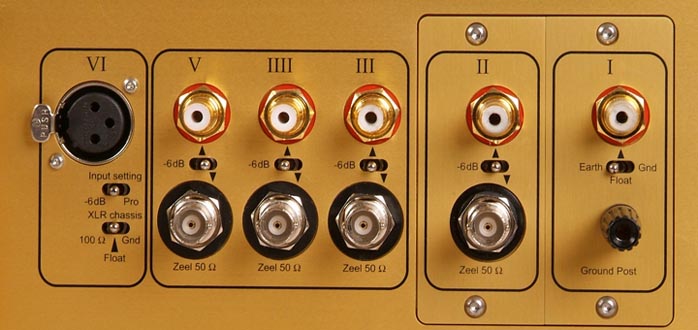 |
|
As a personal favorite and challenge to the system, Nat King Cole's Greatest Hits [DCC] is an amazing record, especially realizing that the music was originally recorded 40 to 50 years ago. It offers wide dynamics and -- when all the gods are in alignment -- a spooky, eerie in-room presence. With "Orange Colored Sky", the brass is right on the very edge of harshness and slightly aggressive. Played with sub-par components or misaligned VTF/VTA, you will quickly cover your ears to hide. Go too far the other way towards warmth, lushness and tubiness and you get dull, boring, and overly sweet. The darT nails this one too.
Some components can flesh out a vivid soundstage but have a somewhat fuzzy indistinct area between the individual instruments. The overall soundfield might appear exact but not real when compared to live music. This diffuse nature in defining the air around the instruments betrays the music as a reproduction. Whether it's the extended bandwidth, solid phase response or some other design criteria, the darTZeel preamp and amp are clearly in a class by themselves when it comes to fleshing out the air and distinct area between instruments.
Every high end manufacturer aspires to build components to convey the sound with a minimum of electronic artifacts. Excluding the theoretical "straight line with gain", every electronic device unfortunately has a character and therefore, artifacts. You might like them and they may sound good to your ears, but they impart electronic characteristics different from the original music. Don't kid yourself, the 18NS will not magically allow an orchestra to appear life-sized in your living room either. What it will do is strip away more of the artificial nature of reproduction, allowing you to get lost in the music with a deep emotional immersion. There is a purity of timbre that favors neither the bass nor highlights the treble. It just has the tonally right feeling of beautiful music. The 18NS simply reduces the artifacts present in most reproduced music which sends audible clues to your brain that you are listening to reproduced music, allowing the music to appear relatively more alive.
|
|
 |
|
|
|
Soundstage
The 18 is forceful without the slightest hint of strain. With Dave Brubeck's Take Five, Time Out [Dave Brubeck Quartet, Classic Records] lesser components tend to compress and dampen the dynamic moment of impact when the drums literally explode into the room. Leading edges are softened and trailing edges are at times compressed. Not so with the darts; the drums literally detonate into the room with startling realism.
|
|
|
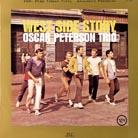 |
|
| The 18 scales beautifully from Oscar Peterson's small trio on West Side Story [DCC] to Wagner's Ride of the Valkyries, Die Walküre [Eric Leinsdorf, Los Angeles Philharmonic, Sheffield Labs]. Size is properly maintained. On one end of the spectrum, Peterson's Trio is |
|
not overblown with 10 foot-wide saxophones nor is the Los Angeles Philharmonic compressed. Each is presented in a very natural, precise soundstage. In both instances you can close your eyes and imagine the instruments reproduced with their various intensities with tonally right harmonic characteristics. Another lovely test passed with ease is Mussorgsky's Night on Bald Mountain [Leonard Maazel, The Cleveland Orchestra, Telarc]. From a single haunting violin, through massed strings to a crushing crescendo, this recording will tell you a lot about your system. Once again, the darT acts as essentially a massive pipe allowing the music to flow through unaltered.
|
|
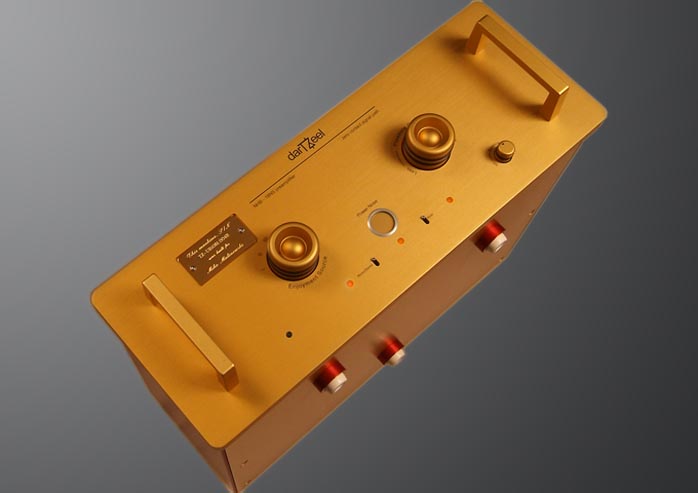 |
|
|
Bass
My first casual reaction to the darTZeel was that possibly the frequency response was tilted ever so slightly upward with a slight lack of bottom end impact. But then there is a reason reviewers get paid the big bucks. It's for the long-term critical evaluation of components using a variety of sources, not for snap judgments. And over the long haul, it became clear that the 18 did not add or subtract anything. It just revealed.
The bass is distinct, taut and focused, painted not as a single homogenous note but with far more complexity. The sound of the drum from the initial thwack changes and envelops you with a startling top-to-bottom clarity and purity, exceeding every preamp in my history including the magnificent VTL 7.5. This clarity is manifested by the revelation of minute details and nuances buried in the musical event.
Although the bass is as tight and delineated as I've ever heard in my system, it does not have the greatest perceived slam. Hervé hypothesizes that amps with temporal distortion and phase shift cause artifacts that produce large and boomy bass. Hervé cautioned to judge the bottom end based upon the tautness, definition, control and depth - not the perceived amplitude.
|
|
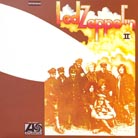 |
|
If you want clean, loud and deep, this baby loves being turned up. The 18 can rock out with the best of them. "Heartbreaker", Led Zepplin II [Classic Records] which can sound a touch thick, came through crisp, clean and lightning fast. As I mentioned before in my speaker analogy, the 18 shares some characteristics with electrostatic speakers. I fondly recall my Acoustat 2+2s and I referenced them several times in my listening notes. The 18's speed, detail and cohesion bring me back to memories of the Acoustats but with a far more natural midrange (no plasticity), and with a bottom end far deeper and tighter than the Acoustat could ever dream of (of course now I listen to Wilson Alexandrias too).
|
|
Highs
At the other extreme, the darT presents a wonderful top end that seems to extend, well, forever. Bells, cymbals, chimes are rendered with a shimmer and ethereal beauty, which floats in space and cuts through the other instruments, ultimately fading with a wonderful decay.
We have all heard components with extended highs presented with somewhat of a hardness or texture. Not so with the darTZeel. The 18 renders highs with a total lack of grain, analogous in video to a switch from a standard analog video signal to 1080P HD.
Imaging
Imaging is life-sized and definitely not overblown, with a soundstage that does not slam you with an in-your-face presentation. While it does extend out from the front plane of the speakers and deeply behind the speakers, it does not throw the listener into the sound field as some components do. The darT presents the music to the listener, it does not immerse the listener in the musical stage. At times, some components can present an exaggerated sense of height. Ella Fitzgerald appearing fifteen feet tall might be exciting in a hi-fi sense but not realistic. The darTZeel nails this perspective perfectly with images scaled very realistically.
|
|
|
|
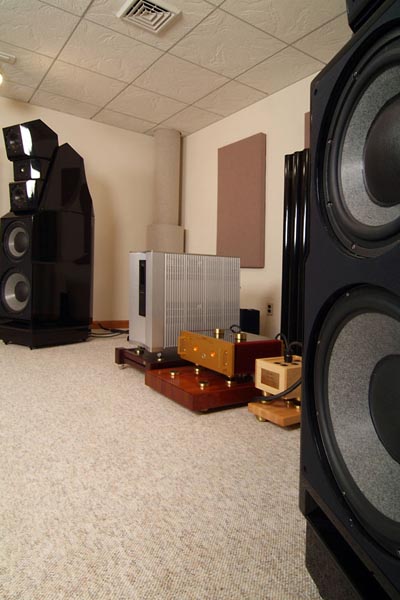 |
|
| Transients are razor-sharp and well defined which in my experience leads to wonderful PRaT (Pace Rhythm and Timing). This speed and resolution allows you to hear many subtle details previously buried in the mix. As a person |
|
been blessed with a high resolution system, I never imagined at this point in my listening career that I would be re-discovering detail and information from sources which I have heard dozens if not hundreds of times. Yet in the past few years, it has happened three times: with the Walker turntable, the Wilson X-2 speakers and now with the DarTZeel amp/preamp combo.
The darts display a fascinating characteristic which I often find in live music - the ability to focus either on only a specific instrument (or group of instruments), or to defocus and absorb the performance as a whole. The theory is that specific brain cells retune themselves to specific sounds and adapt to make a sort of feedback process for auditory focus. Whatever the explanation, I really enjoy this phenomenon and it allows me to listen to music on several levels. Sometimes I want to listen to the individual instruments, melodies and rhythms; at other times I just zone out and listen to the overall musical experience. I find the ability to do this far more often with live music vs. reproduced music yet with the 18, it's pretty easy to choose my focus.
|
|
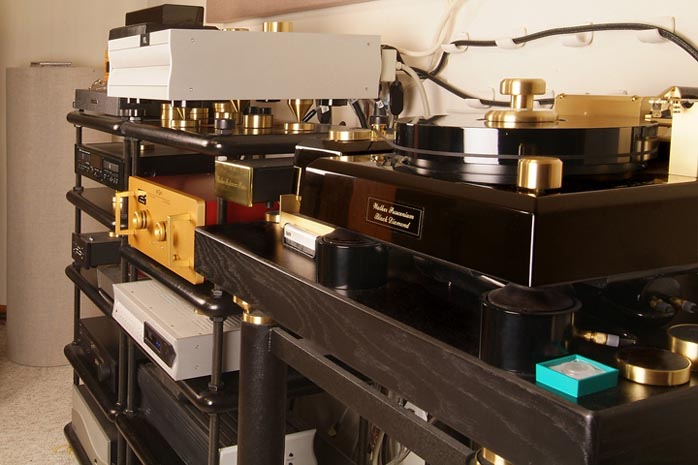 |
|
|
Phono
I have been fortunate to hear some great phono preamps both in my system and in other high-resolution setups. The list is among the Who's Who of great designs - Aesthetix, Manley Steelhead, Lamm, Levinson Reference and even my old Krell, which if memory serves me correct was a spectacular value for the money and highly underrated. There are certainly other contenders in this elite class: the Connoisseur and Boulder come to mind. For me the Walker Reference sits as my current preamp of choice. Two logical questions are, how does the 18's built-in phono sound in an absolute sense and how does it stack up to the competition? The first question is easy. Every sonic description about the preamp applies to its phono input as well: dynamics, spectacular detail, ultra quiet backgrounds and an almost unbelievable lack of grain. Without repeating everything, suffice it to say that if you like the 18NS as a line stage, you will like the phono section - guaranteed. They are obviously cut from the same sonic fabric.
How does the phono stage compare with the best? Based on my experience, some general observations. I find the Lamm to be an exceptional and first-rate musical component but just ever so slightly dark. Although the Steelhead offers unmatched flexibility, the Lamm exceeds it in liquidity and emotional involvement. The tubed beast, the Aesthetix, is flexible, dynamic and blooms naturally into the room. When I heard it however, it was not the final word in low noise, although I have not heard the most current upgrade. The Levinson Reference, while good, is frankly not quite in the same league as the others.
Fortunately I was able to compare the Walker and darTZeel phono sections. In my review of the Walker reference preamp, I asked "Does the music touch your soul? Are you emotionally fulfilled after an evening of listening? Are you drawn into the music? Is your body filled with goose bumps? These are what matter most to me." My answer was that the Walker delivered these above and beyond the competition. During the past several years, Walker has not stood still with phono preamp design. My unit has been modified approximately four times during that period. The improvements were not minor and in a head-to-head comparison, I still prefer in the Walker slightly over the DarTZeel. This is not a criticism of the darTZeel's performance but more of a tribute to Walker. It just delivers a little more of that musical magic that keeps one enthralled. Admittedly, the comparison is rather unfair since the Walker as a standalone phono preamp costs over $12,000 - without a line-level preamp. As to the others, moving back in my aural memory, I would rate the entire DarTZeel slightly above the Lamm for its amazing resolution, dynamics and continuity. [At the time of publication, darTZeel's fact-check session informed us of a running upgrade to the phono section. Maintaining the same phono sound signature, S/N ratio has been improved by 8dB and 2 transistors were removed from the signal path. Quipped the designer, "of course this update does not invalidate the current phono stage, it's just a small step toward the logical quest for the Holy Grail..." - Ed.]
|
|
|
 |
|
|
What's the deal with Zeel?
Let's take a little detour from the subjective review to examine another one of Hervé's unique design elements built into both his amp and preamp - the Zeel connections. With the hundreds if not thousands of types, brands and price points in high-end audio cable, why does darTZeel believe that we need a new incompatible interconnect system? Further in the mysterious world of cables which have both legitimate manufacturers and a touch of snake oil, what makes darTZeel different? The answer is some pretty interesting science. I will leave it to the engineers in the audience to explore the subject farther but I shall offer a layman's overview.
During his early days in design, Hervé became intrigued with cables though not necessarily from an aural perspective. While he clearly heard differences in design, his fascination really stemmed from his inability to correlate design differences with the ultimate sound produced by the cables. Through his research at the Engineering School of Geneva, Hervé tries to solve this riddle. His research and analysis are above my understanding so bear with me in this rather simplified overview of his work, leading to the development of the Zeel connection.
Before we get started, a couple of basic definitions on impedance and resistance: Resistance is used with direct current, defined as equaling voltage divided by current (R = VD/C ÷ A D/C). Impedance is the alternating current equivalent of resistance (Z = VA/C ÷ A A/C), with both resistance and impedance measured in ohms (Ω). The primary difference between the two is that impedance varies with frequency.
Virtually all modern audio equipment uses low impedance sources and high impedance loads. When this input ratio is ten or higher, all is well, meaning that for example the CD output stage will have no problem driving the input of the preamplifier while offering maximum voltage transfer. |
|
|
|
 |
 |
|
|
 |
|
|
|
|
|
|
|
|
|
|
|
|
|
|
|
|
|
|